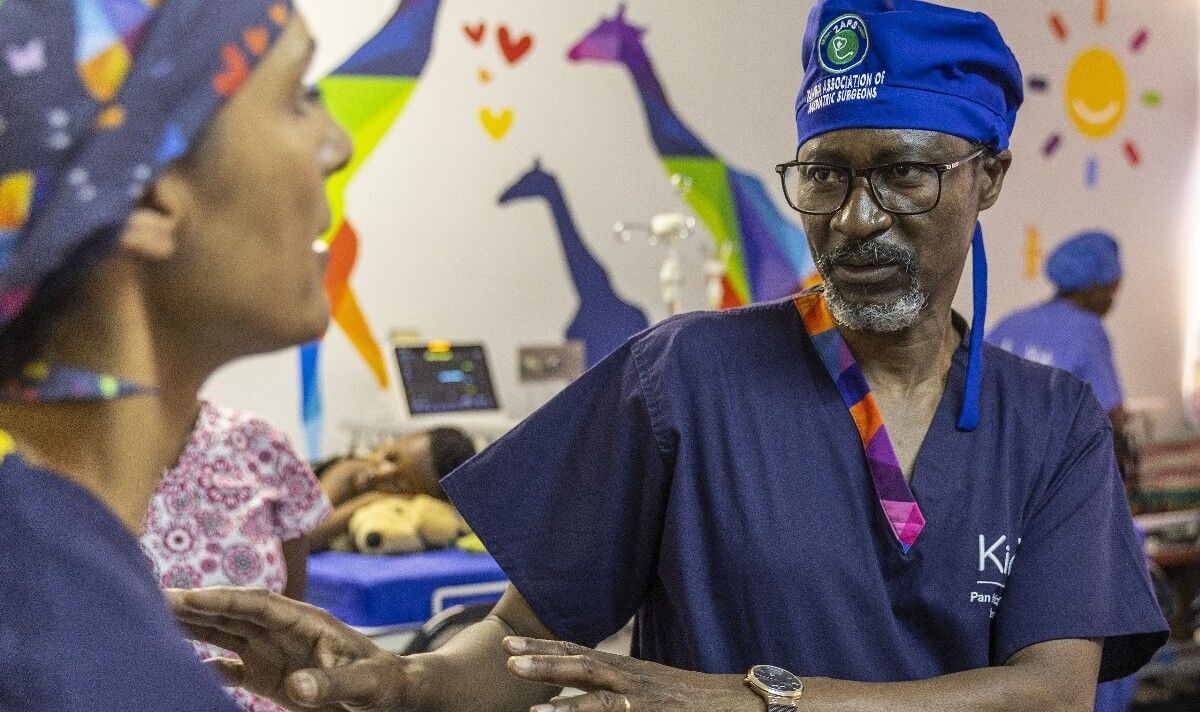
NASA joins forces with UK charity to help save young lives with space technology (Image: GETTY/KIDSOR)
A Scottish charity that helps sick children has partnered with NASA to explore using space-age technology to save young lives in developing countries.
Kids Operating Room (KidsOR), an organisation dedicated to ensuring every child has access to safe surgery in developing countries, and the USA’s National Aeronautics and Space Administration (NASA) announced the groundbreaking initiative today.
They will collaborate to research how emerging oxygen generation technology can potentially save young lives in the world’s most vulnerable locations.
Garreth Wood, Co-Founder and Chairman of KidsOR, described the collaboration as a “dream come true”.
He said: “Our partnership with NASA has significant and life-changing potential for patients across low-resource settings.
“Access to surgery in low- and middle-income countries is incredibly challenging, particularly in those areas experiencing war, climate-related challenges, or civil unrest.
“I am extremely proud that our expertise in developing complex surgical facilities in low-resource settings, and training the local teams to independently sustain their own service, has made us the perfect partner to work with NASA on this exciting research project.
“Our expert team of engineers here in Scotland and across sub-Saharan Africa are understandably thrilled to be working with NASA to potentially transform care for children.
“Taking space shuttle technology to the most remote, most vulnerable child and helping save their life – that’s a dream come true for all of us at Kids Operating Room.”
Don’t miss… NASA shares new images from Mars and nobody can believe how clear they are [PICTURES]

Kids Operating Room is dedicated to ensuring children have access to safe surgery (Image: Kids Operating Room)
The new partnership will see KidsOR test an innovative technology – Medical Ceramic Oxygen Generator or “M-COG” – to generate medical-grade oxygen on-site in hospitals based in low and middle-income countries.
M-COG is a device that creates oxygen with a purity of over 99.99%. It uses advanced ceramic technology to extract oxygen from the air using a sophisticated process called oxygen ion transport.
As air flows across the surface of the ceramic ion transport material, some of the oxygen in the air is electrochemically split into oxygen ions, and transported across the ceramic membrane, where the oxygen ions recombine into pure oxygen.
The device has no moving parts, meaning it requires almost no maintenance once it is in use, making it perfect for resource-poor settings.
A prototype of the technology was tested at NASA’s White Sands Test Facility in Las Cruces, New Mexico.
These initial tests, which are engineering evaluations and the oxygen will not yet be administered to patients, demonstrated that M-COG technology is capable of producing high purity, pressurised oxygen.
Don’t miss… Incredible moment a dry lake on the Sahara desert fills with water [INSIGHT]

M-COG is a device that creates oxygen with a purity of over 99.99% (Image: KIDSOR)
Because of the modular nature of the technology, M-COG can be used for small-scale systems supplying medical oxygen to clinics, or large-scale systems supplying medical oxygen to large tier 1 hospitals.
John Graf, Engineer at NASA, said: “It is amazing to think that technology being developed to help get humans to Mars can help to save lives along the way.
“While we at NASA often use established technology, the unique demands of space exploration sometimes require us to develop new solutions, which must be thoroughly tested on Earth first.
“The chance to explore how we deploy M-COG in hospitals for Kids Operating Room in low-income countries is a perfect example of this synergy.”
The technology, which will be deployed in pediatric surgical facilities and children’s hospitals, has been developed by NASA over many years for possible use in future missions to the Moon and Mars.
A lack of access to reliable oxygen supply is a critical issue in hospitals and operating rooms in low-income countries.

Kids OR and NASA hope emerging oxygen generation technology can potentially save young lives (Image: KIDSOR)

A lack of access to reliable oxygen supply is a critical issue in hospitals in low-income nations (Image: KIDSOR)
The causes for this range from poor infrastructure and supply chain limitations to financial constraints, leaving vulnerable populations at a greater risk of illness and leading to less successful – and sometimes fatal – outcomes in surgery.
Millions of lives are lost each year to respiratory infections caused by a lack of oxygen in hospitals.
Respiratory illnesses are the world’s biggest infectious killer: they claimed 2.2 million lives, including 502,000 children under five, in 2021. That is equivalent to 250 people dying every hour.
KidsOR and NASA will also work alongside Public Invention (a US 501c3 public charity) and Global Hospital to deliver this project.
This involves testing M-COG’s ability to provide hospitals and surgical facilities in LMICs with reliable sources of pressurised medical oxygen that could one day accommodate an operating room’s oxygen requirements.
Combining NASA’s advanced technology with KidsOR’s expertise in establishing state-of-the-art surgical facilities in vulnerable locations, it is hoped that children no longer die unnecessary deaths because of a lack of oxygen.
KidsOR will initially test the new technology for use in medical environments at its Centre for Global Operations in Dundee, Scotland, and simultaneously at surgical facilities in Zambia.
Developing advanced monitoring and power solutions, KidsOR expects to publish outcomes from its work with NASA throughout the partnership.
In time, the technology could be deployed across the charity’s 100 surgical centres spread across 40 countries and beyond.











